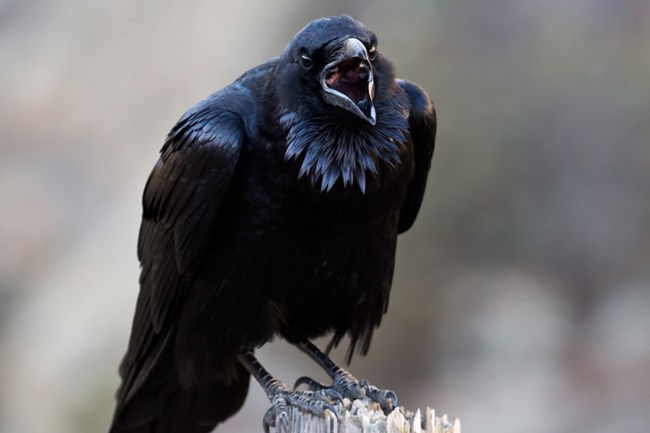
Scientific Name Introduction
Appearance Common ravens are entirely black, right down to the legs, eyes, and beak. The raven is not just large but massive, with a thick neck, shaggy throat feathers, and a Bowie knife of a beak. In flight, ravens have long, wedge-shaped tails. They're more slender than crows, with longer, narrower wings, and longer, thinner “fingers” at the wingtips. Range
The park’s ecological monitoring program detected increases in raven populations on San Miguel and Santa Rosa Islands in the past two decades. 4 Both increases may be due to the ability of ravens to capitalize on novel food resources. The increase on Santa Rosa may be tied to the availability of deer and elk carcasses, when those non-native ungulates were hunted as part of a commercial hunt operation. Ravens on San Miguel began taking advantage of pinniped carcasses made available in the early 1990s due to mortality by hookworms, and that may have fueled their increase on that island. Habitat Feeding Reproduction Juveniles begin to court at a very early age, but may not bond for another two or three years. Aerial acrobatics, demonstrations of intelligence, and ability to provide food are key behaviors of courting. Once paired, they tend to nest together for life, usually in the same location. Instances of non-monogamy have been observed in common ravens, by males visiting a female's nest when her mate is away. Breeding pairs must have a territory of their own before they begin nest-building and reproduction, and thus aggressively defend a territory and its food resources. Nesting territories vary in size according to the density of food resources in the area. The nest is a deep bowl made of large sticks and twigs, bound with an inner layer of roots, mud, and bark and lined with a softer material, such as deer fur. The nest is usually placed in a large tree or on a cliff ledge, or less frequently in old buildings or utility poles
In most of their range, egg laying begins in late February. Females lay between three to seven pale bluish-green, brown-blotched eggs Incubation is about 18 to 21 days, by the female only. However, the male may stand or crouch over the young, sheltering but not actually brooding them. Young fledge at 35 to 42 days, and are fed by both parents. They stay with their parents for another six months after fledging. Conservation Status Additional Information
|
Last updated: June 28, 2016
